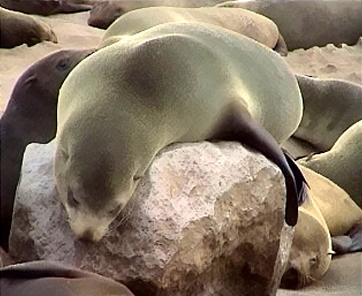|
| 질의: description | 결과: 9506번째/10150 | |
South African or Cape Fur Seal (Arctocephalus pusillus) - Wiki
| 제목: | South African or Cape Fur Seal (Arctocephalus pusillus) - Wiki
| |

| 해상도: 362x296
파일크기: 85294 Bytes
등록시간: 2007:12:20 17:28:43
|
Cape Fur Seal
From Wikipedia, the free encyclopedia
Order: Carnivora
Suborder: Pinnipedia
Family: Otariidae
Subfamily: Arctocephalinae
[Photo] South African Fur Seal, Arctocephalus pusillus, taken at Cape Cross, Namibia. Author Robert Raderschatt (http://de.wikipedia.org/wiki/Benutzer:Robert.raderschatt). License: public domain.
The Cape Fur Seal (also known as the South African Fur Seal and the Australian Fur Seal) is a species of fur seal.
Physical description
The Cape fur seal has a large broad head and a pointed snout. Males are brown to dark gray with a darker mane and a light underside. They grow up to 2.2m (7ft) and weigh around 200-360 kg (440-800lb). Females are gray to light brown with a dark underside and light throat. They grow up to 1.7m (5ft) and weigh on average 120kg (260lbs). Pups are black at birth but turn gray with a pale throat after molting.
Distribution and habitat
The Cape Fur Seal is found along the coast of Namibia and along the west coast of South Africa to the Cape of Good Hope and the Cape Province. Its Australian subspecies breeds on nine islands in the Bass Strait between Tasmania and Victoria.
Both subspecies mostly haul out and breed on rocky islands, rock ledges or reefs and pebble or boulder beaches. However South African Fur Seals have large breeding sites on sandy beaches in South Africa, and a non-breeding group regularly hauls out on a sandy beach in Cape Fria in northern Namibia.
Foraging
Cape fur seals feed mostly on bony fish as well as cephalopods, crustaceans and even birds. The Australian subspecies forages at the bottom of the continental shelf while the African subspecies forages in the open ocean.
Behavior and reproduction
Although cape fur seals normally travel alone, large group of theses seals can be seen rafting in kelp beds. Pregnant females will stay 7 weeks away from the land before the breeding season.
Cape fur seals breed in mid-October. Unlike most eared seal species, females are free to choose their mate and he is judged based on the value of his territory. Both males and females fight for territories with individuals of the same sex. Females have smaller territories and a male's territory may overlap that of several females. A harem may consist of 50 females for one male.
Pups are usually born between late November and early December. After they are born the females start to mate with their harem leaders. The female spends the next several month foraging at sea and nursing her pup, who is weaned at four months old. The pups begin swimming at an early age and the time they spend in the water increases as the pup learns more. By seven months the pup can already swim for two to three days at a time.
The Cape fur seal's main predator is the Great white shark. In False Bay, the seals employ a number of anti-predatory strategies while in shark-infested waters such as:
Swimming in large groups
Low porpoising; to increase sub-surface vigilance
When a shark attacks a group, the seals would dart in different directions to cause confusion.
When being chased by a shark, a seal would ride near the dorsal fin to keep out of reach of the shark's jaws.
Human interactions
The Cape Fur Seal is an inquisitive and friendly animal when in the water and will often accompany SCUBA divers. They will swim around divers for periods of several minutes at a time, even at a depth of 60m. On land they are far less relaxed and tend to panic when people come near them.
Australian Fur seals were hunted greatly between 1798 and 1825 for commercial reasons. Seal hunting stopped in Australia in 1923 and their population is still recovering. Breeding and haul out sites are protected by law. However the Tasmanian government authorized the killing of "nuisance" fur seals in October 2000.
South African fur seals have a very robust and healthy population despite annual harvesting.
http://en.wikipedia.org/wiki/Cape_Fur_Seal
| The text in this page is based on the copyrighted Wikipedia article shown in above URL. It is used under the GNU Free Documentation License. You may redistribute it, verbatim or modified, providing that you comply with the terms of the GFDL. |
|
^o^
동물그림창고 똑똑전화 누리집
^o^
|
|